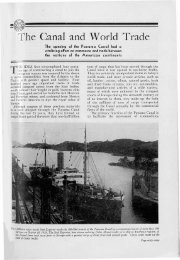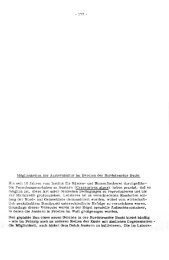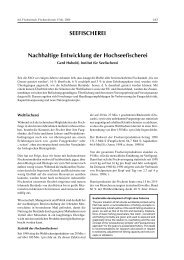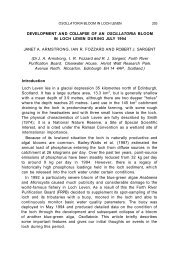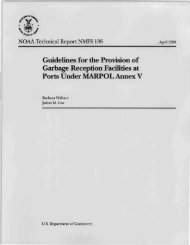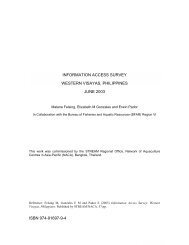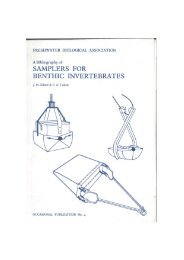The Economic Importance Of Marine Angler Expenditures In
The Economic Importance Of Marine Angler Expenditures In
The Economic Importance Of Marine Angler Expenditures In
You also want an ePaper? Increase the reach of your titles
YUMPU automatically turns print PDFs into web optimized ePapers that Google loves.
ing NE states, however, there are very few petroleum<br />
refineries so this percentage fell to about 30% across<br />
other NE states.<br />
<strong>The</strong> American Sportfishing Association (ASA) recently<br />
published estimates of marine recreational fishing<br />
expenditures and the economic impacts of these<br />
expenditures, based on the 2001 U.S. Fish and Wildlife<br />
Service’s survey (USFWS) of fishing, hunting, and wildlife<br />
related recreation (ASA, 2002). <strong>In</strong> the ASA report,<br />
anglers were estimated to have spent $11.3 billion on marine<br />
recreational fishing in 2001 in the U.S., a two-fold<br />
difference from our estimate of expenditures ($22.6 billion).<br />
Across states, the ASA’s expenditure estimates are<br />
anywhere from 1.1 times lower in New Hampshire, to 6<br />
times lower in Mississippi. <strong>The</strong>re are two primary reasons<br />
why our estimates of expenditures are higher than those<br />
reported in the ASA report. First, the expenditure estimates<br />
presented in this study are based in part on MRFSS<br />
effort and participation estimates that are generally<br />
higher than those derived from the USFWS 11 . Secondly,<br />
differences in sampling procedures likely contributed<br />
to disparities between the expenditure estimates. <strong>The</strong><br />
MRFSS sampling rate is considerably higher and was<br />
specifically designed to target only recreational saltwater<br />
anglers. <strong>In</strong> contrast, the USFWS targets freshwater anglers,<br />
saltwater anglers, hunters, and other recreational<br />
activities as an add-on to the decennial census. <strong>The</strong>se<br />
factors combined, contribute to the two-fold differences<br />
in expenditure estimates from the two surveys.<br />
<strong>The</strong> ASA report also used the 2001 USFWS expenditure<br />
estimates to calculate the economic impacts of<br />
saltwater recreational angling across states and to the<br />
nation as a whole. Nationwide, it was estimated that<br />
saltwater angling generated $31.1 billion in sales, $8.1<br />
billion in income, and supported about 297,000 jobs.<br />
Although our nationwide estimates do not include<br />
impacts generated in Texas, Alaska, or Hawaii, the economic<br />
impact estimates presented here are similar for<br />
sales ($30.5 billion), substantially higher for personal<br />
income ($12.0 billion), and slightly higher for employment<br />
(350,000 jobs). <strong>The</strong>se similarities, however, are<br />
purely coincidental. <strong>The</strong> ASA report uses RIMS II<br />
multipliers to estimate economic impacts from angler<br />
expenditures 12 . RIMS II multipliers are comparable<br />
to the IMPLAN multipliers generated in this study, in<br />
11 At the national level, MRFSS participation estimates were 1.3 times<br />
higher than the USFWS estimates. Across states, MRFSS participation<br />
estimates were anywhere from 1.3 times higher in New York<br />
to 3.8 times higher in Delaware. MRFSS estimates of effort at the<br />
national level were slightly lower than the USFWS estimates. However,<br />
the difference in effort estimates across states ranged from<br />
0.8 times lower than the USFWS estimates in California, Louisiana,<br />
and South Carolina to 2 times higher than the USFWS estimates in<br />
North Carolina.<br />
12 Southwick, R. 2002. Personal commun. Southwick Associates, P.O.<br />
Box 6435, Fernandina Beach, FL 32035.<br />
8<br />
the sense that both multipliers are directly linked to<br />
the amount of angler expenditures that affect local<br />
businesses within the geographical area of interest. 13<br />
<strong>The</strong>refore, it is incumbent on the researcher to remove<br />
imports and household-to-household purchases<br />
before applying the RIMS II or the IMPLAN-generated<br />
multipliers when calculating recreational expenditure<br />
impacts in a particular geographical area. <strong>The</strong> IMPLAN<br />
Pro system provides users with the ability to remove the<br />
value of imports from the regional economic accounts<br />
prior to generating impacts. Unfortunately, no attempt<br />
was made to remove imports from the national or statelevel<br />
assessments conducted for the ASA report. Impacts<br />
were estimated by simply multiplying the USFWS<br />
expenditure estimates by the RIMS II multipliers. <strong>The</strong><br />
ASA report also assumed that there were no householdto-household<br />
sales of homes, boats, or vehicles. All durable<br />
expenditures were assumed to occur at the retail<br />
level. As a result, the national and state-level impact<br />
assessments conducted for the ASA report overstate<br />
the relationship between angler expenditures and the<br />
impacts generated from those expenditures.<br />
From a regional perspective, the NE state-level impact<br />
numbers shown here are lower than estimates in<br />
previous studies (see Storey and Allen, 1993; Kirkley<br />
and Kerstetter, 1997; Maharaj and Carpenter, 1998).<br />
Maharaj and Carpenter (1998) generated estimates for<br />
all 50 states in the U.S., while Kirkley and Kerstetter<br />
(1997) and Storey and Allen (1993) focused on single<br />
states (Virginia and Massachusetts, respectively). All<br />
three studies combined marine angler expenditure<br />
data with an input-output model, but only Kirkley and<br />
Kerstetter (1997) used the data contained within the<br />
IMPLAN system to account for the effects of imports on<br />
local supply. Maharaj and Carpenter (1998) estimated<br />
the total economic impacts generated from angler expenditures<br />
in each state, but these estimates appear to<br />
include impacts that accrue to other regions through<br />
domestic and foreign imports. 14 <strong>The</strong> estimates shown in<br />
13 For example, in terms of sales, the RIMS II and the IMPLAN multipliers<br />
are directly linked to the difference between anglers’ total<br />
expenditures in the region and the total value of imports required<br />
to meet those angler demands. Multiplication of this difference by<br />
the RIMS II or IMPLAN multipliers results in the total sales generated<br />
from angler expenditures in the region. Regional income and<br />
employment impacts are calculated in a similar manner.<br />
14 <strong>The</strong> methodology section in Maharaj and Carpenter (1998) makes<br />
no reference to imports and the authors state “Direct effects of expenditures<br />
on a product produced by industry Y capture the initial<br />
expenditure on a good and the cost of inputs (goods and services)<br />
used by industry Y in producing that good.” This definition would<br />
result in inflated estimates of direct impacts for all expenditure<br />
items that require some level of imports to satisfy angler demands.<br />
<strong>In</strong> other words, direct impacts are only tantamount to initial expenditures<br />
if all of the goods and services used to supply the item<br />
being purchased originated within the region of interest. <strong>Of</strong> the 32<br />
expenditure items purchased by anglers in this study, only 17 were<br />
supplied to anglers without requiring imports.



